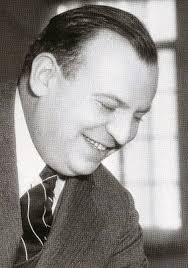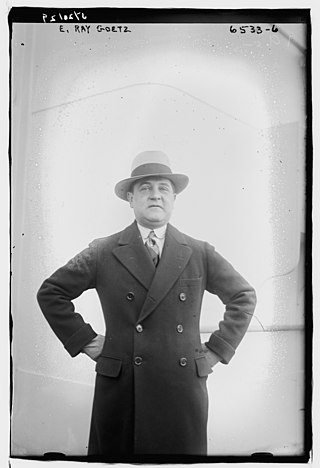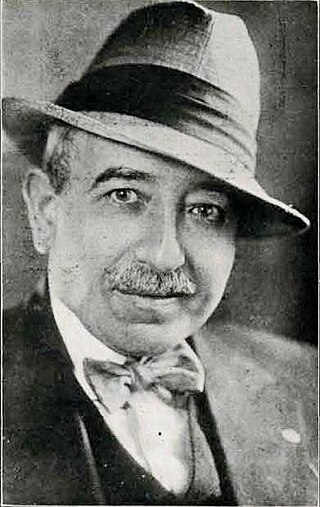
George Gard "Buddy" DeSylva was an American songwriter, film producer and record executive. He wrote or co-wrote many popular songs, and along with Johnny Mercer and Glenn Wallichs, he co-founded Capitol Records.

Tin Pan Alley was a collection of music publishers and songwriters in New York City that dominated the popular music of the United States in the late 19th and early 20th centuries. Originally, it referred to a specific location on West 28th Street, between Fifth and Sixth Avenues in the Flower District of Manhattan, as commemorated by a plaque on 28th Street between Broadway and Sixth. Several buildings on Tin Pan Alley are protected as New York City designated landmarks, and the section of 28th Street from Fifth to Sixth Avenue is also officially co-named Tin Pan Alley.

M. Witmark & Sons was a leading publisher of sheet music for the United States "Tin Pan Alley" music industry.

Gustav Gerson Kahn was an American lyricist who contributed a number of songs to the Great American Songbook, including "Pretty Baby", "Ain't We Got Fun?", "Carolina in the Morning", "Toot, Toot, Tootsie ", "My Buddy" "I'll See You in My Dreams", "It Had to Be You", "Yes Sir, That's My Baby", "Love Me or Leave Me", "Makin' Whoopee", "My Baby Just Cares for Me", "I'm Through with Love", "Dream a Little Dream of Me" and "You Stepped Out of a Dream".

Alexander Dubin was an American lyricist. He is best known for his collaborations with the composer Harry Warren.

Robert Russell Bennett was an American composer and arranger, best known for his orchestration of many well-known Broadway and Hollywood musicals by other composers such as Irving Berlin, George Gershwin, Jerome Kern, Cole Porter, and Richard Rodgers.
The Great American Songbook is the loosely defined canon of significant 20th-century American jazz standards, popular songs, and show tunes.

The National Music Publishers' Association (NMPA) is a trade association for the American music publishing industry. Founded in 1917, NMPA represents American music publishers and their songwriting partners. The NMPA’s mandate is to protect and advance the interests of music publishers and songwriters in matters relating to the domestic and global protection of music copyrights.
A song plugger or song demonstrator was a vocalist or piano player employed in the early 20th century by department stores, music stores and song publishers to promote and help sell new sheet music, which was how hits were advertised before good-quality recordings were widely available. Music publisher Frank Harding has been credited with innovating the sales method. Typically, the pianist sat on the mezzanine level of a store and played whatever music was sent up to him by the clerk of the store selling the sheet music. Patrons could select any title, have it delivered to the song plugger, and get a preview of the tune before buying it.
Isaac Goldberg was an American journalist, author, critic, translator, editor, publisher, and lecturer. Born in Boston to Jewish parents, he studied at Harvard University and received a BA degree in 1910, a MA degree in 1911 and a PhD in 1912. He traveled to Europe as a journalist during World War I writing for the Boston Evening Transcript.

Warner Chappell Music, Inc. is an American music publishing company and a subsidiary of the Warner Music Group. Warner Chappell Music's catalog consists of over 1.4 million compositions and 150,000 composers, with offices in over 40 countries.
Ren Shields was an American folk musician born in 1868 in Chicago, Illinois. He died on 25 October 1913 in Massapequa, New York. He co-wrote the song with George "Honey Boy" Evans "In the Good Old Summer Time",, amongst other songs, such as "Dreamy Eyes", and "Come, take a Trip in My Air-ship".
Francis, Day & Hunter is a British music publishing company, one of the leading publishers of music hall songs and popular music in the late 19th and 20th centuries. It was established in London in 1877 as W. & J. Francis and Day, later Francis Brothers & Day, becoming Francis, Day & Hunter in 1880. It became a subsidiary of EMI Publishing in 1972.

Edward Ray Goetz was an American composer, lyricist, playwright, theatre director, and theatrical producer. A Tin Pan Alley songwriter, he published more than 500 songs during his career, many of them originally written for the New York stage. His songs were recorded by several artists, including Judy Garland, Al Jolson, and Blossom Seeley. He was active as both a lyricist and composer for Broadway musicals from 1906 through to 1930, collaborating with artists like George Gershwin, Cole Porter, Sigmund Romberg, and A. Baldwin Sloane to create material for the theatre.

"The Little Lost Child" is a popular song of 1894 by Edward B. Marks and Joseph W. Stern, with between one and two million copies in sheet music sales. Also known after its first three words as "A Passing Policeman", it is usually considered to have been the first work promoted as an illustrated song. The song's success has also been credited to its performance by Lottie Gilson and Della Fox.

Leopold Feist, in 1897 founded and ran a music publishing firm bearing his name. In the 1920s, at the height of the golden age of popular music, his firm was among the seven largest publishers of popular music in the world. Leo Feist, Inc., ran until 1934. The company used the motto "You can't go wrong, with any FEIST Song."
Miss 1917 is a musical revue with a book by Guy Bolton and P. G. Wodehouse, music by Victor Herbert, Jerome Kern and others, and lyrics by Harry B. Smith, Otto Harbach, Henry Blossom and others. Made up of a string of vignettes, the show features songs from such musicals as The Wizard of Oz, Three Twins, Babes in Toyland, Ziegfeld Follies and The Belle of New York.
Leo Edwards was a Broadway and Tin Pan Alley composer and pianist. He worked closely with Florenz Ziegfeld Jr., writing music for the Ziegfeld Follies for over a decade. He also wrote music for Paul Whiteman and collaborated with his two brothers, the composer Gus Edwards and music publisher and talent agent Ben Edwards, in addition to writing music for several New York music publishing firms.
Max Dreyfus was a German-born American music publisher, arranger and songwriter. Between the 1910s and 1950s he encouraged and published the work of many of the writers of the so-called Great American Songbook, and was president of Chappell & Co., Inc. American office, the world's largest music publishing firm.

Ottalie Mark was an American musicologist, copyright consultant, composer, and music editor.













